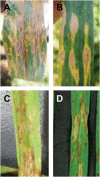A review of wheat diseases-a field perspective
- PMID: 29045052
- PMCID: PMC6638159
- DOI: 10.1111/mpp.12618
A review of wheat diseases-a field perspective
Abstract
Wheat is one of the primary staple foods throughout the planet. Significant yield gains in wheat production over the past 40 years have resulted in a steady balance of supply versus demand. However, predicted global population growth rates and dietary changes mean that substantial yield gains over the next several decades will be needed to meet this escalating demand. A key component to meeting this challenge is better management of fungal incited diseases, which can be responsible for 15%-20% yield losses per annum. Prominent diseases of wheat that currently contribute to these losses include the rusts, blotches and head blight/scab. Other recently emerged or relatively unnoticed diseases, such as wheat blast and spot blotch, respectively, also threaten grain production. This review seeks to provide an overview of the impact, distribution and management strategies of these diseases. In addition, the biology of the pathogens and the molecular basis of their interaction with wheat are discussed.
Keywords: Fusarium head blight/scab; Helminthosporium; Magnaporthe; blotch; fungal pathogens; rusts; wheat diseases.
© 2017 BSPP AND JOHN WILEY & SONS LTD.
Figures



Similar articles
-
Evolution of the wheat blast fungus through functional losses in a host specificity determinant.Science. 2017 Jul 7;357(6346):80-83. doi: 10.1126/science.aam9654. Science. 2017. PMID: 28684523
-
Triple Threat: How Global Fungal Rice and Wheat Pathogens Utilize Comparable Pathogenicity Mechanisms to Drive Host Colonization.Mol Plant Microbe Interact. 2025 Mar;38(2):173-186. doi: 10.1094/MPMI-09-24-0106-FI. Epub 2025 Apr 17. Mol Plant Microbe Interact. 2025. PMID: 39807944 Review.
-
Emergence of wheat blast in Bangladesh was caused by a South American lineage of Magnaporthe oryzae.BMC Biol. 2016 Oct 3;14(1):84. doi: 10.1186/s12915-016-0309-7. BMC Biol. 2016. PMID: 27716181 Free PMC article.
-
In-silico study of protein-protein interactions in wheat blast using docking and molecular dynamics simulation approach.J Biomol Struct Dyn. 2024 Jul;42(11):5747-5757. doi: 10.1080/07391102.2023.2228907. Epub 2023 Jun 25. J Biomol Struct Dyn. 2024. PMID: 37357445
-
Disease Impact on Wheat Yield Potential and Prospects of Genetic Control.Annu Rev Phytopathol. 2016 Aug 4;54:303-22. doi: 10.1146/annurev-phyto-080615-095835. Epub 2016 Jan 8. Annu Rev Phytopathol. 2016. PMID: 27296137 Review.
Cited by
-
Multi-Layer Biosensor for Pre-Symptomatic Detection of Puccinia strifformis, the Causal Agent of Yellow Rust.Biosensors (Basel). 2022 Oct 6;12(10):829. doi: 10.3390/bios12100829. Biosensors (Basel). 2022. PMID: 36290966 Free PMC article.
-
Emergence and Potential Spread of Rust Disease on Wisteria floribunda and Corydalis incisa Influenced by Climate Change in Korea.Mycobiology. 2024 May 16;52(3):160-171. doi: 10.1080/12298093.2024.2350836. eCollection 2024. Mycobiology. 2024. PMID: 38948454 Free PMC article.
-
High-resolution genome-wide association study and genomic prediction for disease resistance and cold tolerance in wheat.Theor Appl Genet. 2021 Sep;134(9):2857-2873. doi: 10.1007/s00122-021-03863-6. Epub 2021 Jun 1. Theor Appl Genet. 2021. PMID: 34075443
-
Genome-Wide Identification and Analysis of the NPR1-Like Gene Family in Bread Wheat and Its Relatives.Int J Mol Sci. 2019 Nov 27;20(23):5974. doi: 10.3390/ijms20235974. Int J Mol Sci. 2019. PMID: 31783558 Free PMC article.
-
Loop-Mediated Isothermal Amplification for Detection of Plant Pathogens in Wheat (Triticum aestivum).Front Plant Sci. 2022 Mar 15;13:857673. doi: 10.3389/fpls.2022.857673. eCollection 2022. Front Plant Sci. 2022. PMID: 35371152 Free PMC article. Review.
References
-
- Ali, S. , Gladieux, P. , Leconte, M. , Gautier, A. , Justesen, A.F. , Hovmøller, M.S. , Enjalbert, J. and de Vallavieille‐Pope, C. (2014) Origin, migration routes and worldwide population genetic structure of the wheat yellow rust pathogen Puccinia striiformis f. sp. tritici . PLoS Pathog. 10, e1003903. - PMC - PubMed
-
- Anh, V.L. , Anh, N.T. , Tagle, A.G. , Vy, T.T.P. , Inoue, Y. , Takumi, S. , Chuma, I. and Tosa, Y. (2015) Rmg8, a new gene for resistance to Triticum isolates of Pyricularia oryzae in hexaploid wheat. Phytopathology, 105, 1568–1572. - PubMed
-
- Anikster, Y. , Bushnell, W. , Roelfs, A. , Eilam, T. and Manisterski, J. (1997) Puccinia recondita causing leaf rust on cultivated wheats, wild wheats, and rye. Can. J. Bot. 75, 2082–2096.
-
- Anonymous . (2017) Of rice and men. A circular tale of changing food preferences The Economist, Print Edition, International.
-
- Antoni, E.A. , Rybak, K. , Tucker, M.P. , Hane, J.K. , Solomon, P.S. , Drenth, A. , Shankar, M. and Oliver, R.P. (2010) Ubiquity of ToxA and absence of ToxB in Australian populations of Pyrenophora tritici‐repentis . Austral. Plant Pathol. 39, 63–68.
Publication types
MeSH terms
Grants and funding
- BB/J/00426X/1/BB_/Biotechnology and Biological Sciences Research Council/United Kingdom
- BB/I000488/1/BB_/Biotechnology and Biological Sciences Research Council/United Kingdom
- BB/P016855/1/BB_/Biotechnology and Biological Sciences Research Council/United Kingdom
- BB/K020056/1/BB_/Biotechnology and Biological Sciences Research Council/United Kingdom
- BB/J/004383/1/BB_/Biotechnology and Biological Sciences Research Council/United Kingdom
LinkOut - more resources
Full Text Sources
Other Literature Sources
Research Materials
Miscellaneous

